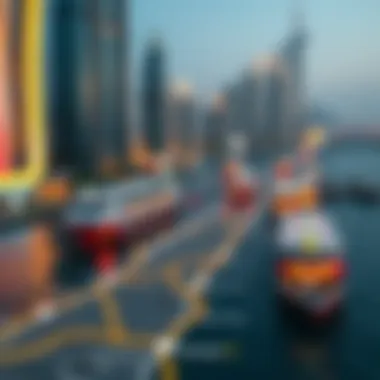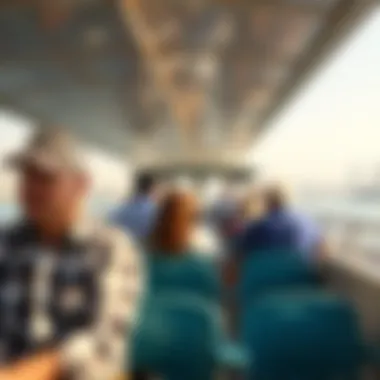Exploring Dubai's Ferry Routes: A Comprehensive Guide


Intro
When one thinks of Dubai, images of towering skyscrapers, luxurious shopping malls, and lush desert landscapes come to mind. Yet, beneath the surface lies a complex and efficient transportation system that includes the often-overlooked ferry routes. These waterways are not just for tourists wanting to soak up the sun on the shores of Dubai; they play a significant role in the city’s transportation dynamics, tourism, and real estate market.
The ferries connect key locations, providing a scenic alternative to road travel. They are particularly advantageous to expats and residents who wish to avoid the notorious traffic jams that the city is known for. As the city expands, the reliance on such innovative transport methods increases. Moreover, understanding the ferry routes offers investors and homebuyers insights into upcoming neighborhoods and commercial spots, shedding light on potential growth areas.
In this exploration, we will scrutinize the ferry services available in Dubai, detail their operational schedules, and examine their economic impacts. Those looking to grasp not only the practicalities of ferry transport but also its influence on lifestyle and investment will find this overview to be an invaluable resource.
Buckle up as we dive deep into the currents shaping Dubai’s waterways.
Preface to Dubai's Ferry System
Dubai's ferry system is not just a mode of transport; it's a significant feature integrated into the fabric of urban mobility in this rapidly growing metropolis. Understanding this system offers a glimpse into how Dubai has evolved its transport infrastructure, making water travel an appealing alternative amid the bustling city life.
The importance of the ferry system goes beyond mere convenience. For residents, the ferries provide an effective way to navigate the city without the hassles that often come with road traffic. As the roads become congested, the waterways offer a solution that contributes to the greater efficiency of urban movement. There’s an unspoken elegance in gliding over the water, a contrast to the chaos often found on land.
Historical Development of Ferry Services
The historical roots of Dubai's ferry services date back several decades. Initially, the concept of water transit was simple, relying on traditional dhows for transportation across the creek. However, as Dubai began its journey towards modernity in the late 20th century, significant strides were made to enhance these services.
In 2006, the establishment of the Roads and Transport Authority marked a turning point. With investments made in both infrastructure and fleet, new, technologically advanced ferries began making their rounds, connecting key points around the coastline. More than just vessels, they turned into symbols of Dubai's commitment to innovation in transportation. As each ferry set sail, it not only transported passengers but also reflected the grand vision that Dubai holds for itself in terms of urban transit.
Purpose and Significance in Urban Mobility
The significance of the ferry system in Dubai’s urban mobility cannot be overstated. It addresses multiple needs in a dynamic landscape where every minute counts. By providing reliable ferry services, authorities have enabled residents and tourists alike to access popular destinations like the Dubai Marina, the Palm Jumeirah, and Al Seef with great ease.
Moreover, the ferries serve as a lifeline for commuting professionals who work in the busy business districts but live in areas away from the bustle. Water transport not only lightens the traffic burden but it also transcends geographical barriers within the city. The convenience of hopping onto a ferry can sometimes mean the difference between being stuck in a traffic jam or enjoying the serene view of the waterway – a small luxury in the midst of an urban rush.
As Dubai continues to expand, the ferry system stands as a testament to forward-thinking urban planning. Each route and every vessel is strategically placed to fulfill not only the demands of today but also to anticipate the needs of the future. For investors, developers, and homebuyers, understanding this transport network opens up new avenues for growth and accessibility, making it an essential aspect of the city’s continuing evolution.
"Waterways are more than just routes; they are arteries pulsing with the vibrancy of urban life."
Overview of Ferry Routes in Dubai
The ferry system in Dubai is more than just a means of transport; it’s a vital component that stitches together the bustling life of this modern metropolis. From traders to tourists, the routes cater to a diverse crowd, reflecting the dynamic nature of Dubai’s economy and culture. Understanding the ferry routes reveals insights into how urban mobility and tourism interact within the city.
One significant benefit of using the ferry system is the unique perspective it offers of the cityscape. Traversing the waters presents travelers with a refreshing view of Dubai’s iconic skyline, which remains an extraordinary backdrop for daily commuters and visitors alike. This opportunity to appreciate the architectural wonders from a different angle cannot be understated.
Major Ferry Lines and Their Destinations
When it comes to navigating through the waterways of Dubai, a handful of major ferry lines stand out, each providing access to key destinations across the city. The Dubai Water Canal route is a prominent choice, as it connects residents and visitors to areas like Downtown Dubai and the vibrant Jumeirah Beach.
Another crucial line is the Marina Line, which links the scenic Dubai Marina to the Dubai Mall and other attractions. It presents a seamless commute for those working in the upscale hotels and offices around the marina, allowing them to travel while enjoying the sea breeze.
A further noteworthy line is the Deira to Bur Dubai route, which serves as a bridge across the historic creek, making it easy for those interested in exploring the rich history of Dubai, including the Dubai Museum and the traditional souks.
These routes not only support daily commuters but also play a significant role in enhancing tourism, as they conveniently connect visitors to cultural landmarks and leisure spots. Moreover, ferries are equipped with modern amenities, ensuring a smooth and comfortable journey for passengers.
Additional Routes and Seasonal Services
Alongside the major ferry lines, there are additional routes and seasonal services that cater to specific regions and events. For instance, the Palm Jumeirah Ferry offers transit to and from the iconic man-made island, serving its residents and resort visitors during peak seasons. Seasonal services, particularly during festivals, enhance accessibility to events held along waterfronts, fostering a spirit of community and celebration.
Moreover, ensuring connectivity during events such as National Day or the Dubai Shopping Festival adds value to the ferry network. These special routes can handle larger crowds, making it easier for both locals and tourists to access festivities without the hassle of road traffic.
"The ferry system is a bridge not only across the water but also between cultures, experiences, and opportunities."
By embracing the unique aspects of this mode of transportation, all who venture into the waters of Dubai can discover the charm of urban life that sits right alongside the sea.
Key Ferry Stations and Accessibility
Understanding the key ferry stations in Dubai provides a solid foundation for navigating the city's ferry system. These stations serve not only as pivotal points for transportation but also as connections to various cultural and recreational sites. The accessibility of these terminals greatly affects both residents and tourists. Whether you're a resident looking to commute or a tourist seeking to explore, knowing the main ferry stations can significantly enhance the travel experience.
Main Ferry Terminals in Dubai
Dubai boasts several main ferry terminals, each uniquely positioned to serve different parts of the city. Here’s a closer look at some of the most significant ones:
- Dubai Marina: The bustling Marina terminal is often the first choice for those looking to enjoy leisure trips. Surrounded by luxurious yachts and impressive skyscrapers, it offers services to various destinations along the coast and to nearby attractions.
- Al Jaddaf: Positioned on the banks of Dubai Creek, Al Jaddaf serves as a gateway to historical sites. Travelers can hop on a ferry here to reach cultural destinations such as the Dubai Museum or the Al Fahidi Historical District.
- Sheikh Zayed Road: The ferry terminal here acts as a major transit point, connecting visitors to the heart of the city. It's strategically located near some landmark shopping centers, making it convenient for tourists aiming to mix retail therapy with ferry adventures.
- Dubai Festival City: This terminal represents the vibrant lifestyle of the city. It’s an area packed with shopping, dining, and entertainment options, making it a popular stop for both residents and tourists.
"Ferry services in Dubai are not just transportation; they are a gateway to experience the city’s charm from a different perspective."
Accessibility for Residents and Tourists


Accessibility of the ferry system is a crucial consideration, especially when evaluating the convenience it offers. The ferry terminals are designed with various features aimed at enhancing the overall experience for all users.
- Public Transport Connections: Most ferry terminals are conveniently linked to other forms of transport, such as metro and bus services. For instance, passengers traveling from the Marina can easily transition to the metro line, further extending their reach within the city.
- Wheelchair Accessibility: Each terminal is equipped with facilities to assist individuals with disabilities. Ensuring that the service is inclusive caters to a broader audience, fostering a community-friendly environment.
- Multiple Payment Options: The terminals are not just places to catch a ride; they also provide various payment options, including the Nol card, which integrates seamlessly with the metro system. This eases the burden of carrying cash and ensures hassle-free travel.
- Tourist Information Centers: Many ferry stations house tourist information centers, where both residents and visitors can seek help about routes, ticketing, or recommendations on local attractions. This ensures that anyone using the ferry system has easy access to information, enriching their journey.
In summary, the key ferry stations serve as vital hubs within Dubai's transportation network. Their strategic locations, accessibility for all users, and additional amenities make them essential to understanding how to navigate the city's waterways. With this knowledge, both residents and tourists can leverage the ferry system to explore Dubai and its rich offerings.
Operational Aspects of Ferry Services
Understanding the operational aspects of ferry services in Dubai is key to comprehending their significance in the city's vibrant transport landscape. These services not only facilitate smooth commuting but also embody the elegant synergy of efficiency and tourism in an ever-evolving metropolis. The operational framework of the ferry system directly impacts user experience, accessibility, and the overall perception of public transport in Dubai. Thus, examining service frequency, timings, ticket pricing, and payment options becomes essential for regular commuters, tourists, and investors alike.
Service Frequency and Timings
When it comes to ferry services in Dubai, the frequency of departures and their respective timings are crucial elements that determine user convenience. Ferries generally operate on a fixed schedule throughout the day, with peak hours seeing increased frequency to accommodate the bustling workforce and tourists alike. For instance, during the mornings and late afternoons, the ferries are almost as busy as a bustling souk, effectively connecting various parts of the city while cutting down travel time significantly.
The main routes tend to operate every 15 to 30 minutes, while some specific lines may have additional services during weekends or holidays, adapting to the flow of tourists and residents. Such operational efficiency ensures that users can rely on timely transit to their destinations, transforming what could be a cumbersome experience into a seamless journey. It is advisable for commuters to check the latest schedules directly through reliable websites, ensuring they are in the loop regarding any changes—especially on public holidays or during special events.
"Timeliness in ferry operations reflects the broader commitment of Dubai to provide high-quality public services."
Ticket Pricing and Payment Options
Navigating the complexities of fare structures adds another layer to the understanding of Dubai’s ferry system. Prices are generally affordable, catering to both casual tourists and daily commuters. For instance, a typical ride could cost around AED 15 to AED 30, depending on the distance travelled. This economical pricing ensures inclusivity, making the ferry an attractive alternative to road transport options, which can get congested during peak hours.
Payment flexibility is another significant aspect. Commuters can purchase tickets either at the ferry stations or through the ubiquitous Nol card system. The Nol card streamlines the travel experience, enabling users to tap in and out without the hassle of cash transactions. Additionally, contactless payment options are progressively being adopted, aligning with global trends towards digital transactions.
It's advisable to keep an eye on promotional offerings or package deals, especially during peak tourist seasons. Such initiatives can make travel even more economical, enhancing the appeal of ferry services.
The Role of Ferries in Dubai's Tourism Industry
Ferries in Dubai play a crucial role beyond just transportation; they are a vital cog in the tourism machinery that drives the city. With its breathtaking skyline and iconic waterfronts, tourists are not merely keen on reaching their destinations. They're looking for experiences that encapsulate the essence of Dubai. The ferry system rises to this occasion, offering scenic routes that effortlessly connect visitors to various landmarks. It’s like taking a little slice of adventure right on the water, with stunning views overshadowing the mundane road trips.
Connecting Major Tourist Attractions
Dubai’s ferry services create a seamless connection between some of the city's most popular tourist spots. Take a ride from the Dubai Marina to the Palm Jumeirah; it’s not just a means of transport, but a visual treat. While the sun sets, tourists get to witness the golden hues reflecting off the water, setting the backdrop for feats of architectural brilliance like the Atlantis resort. The ferry docks at various hotspots such as the Dubai Mall, Dubai Frame, and the historic Bastakiya district, making it an efficient alternative to road traffic.
- Dubai Marina: An upscale area that boasts lifestyle attractions.
- Palm Jumeirah: Home to luxury hotels like the Atlantis.
- Dubai Mall: A retail and entertainment hub, offering more than just shopping.
- Bastakiya District: Echoes the historical essence of Dubai amidst modernity.
This waterway access encourages tourists to plan their days around these routes, enhancing foot traffic and, consequently, benefiting local businesses. Simply put, hopping on a ferry feels like receiving a ticket to explore without the hassle of navigating traffic or dealing with crowded metro stations.
Promotional Initiatives for Tourists
To enhance the ferry experience, the Dubai government has rolled out several promotional initiatives aimed at both tourists and residents. For instance, visitors can enjoy discounted tickets during off-peak seasons, making it easier on the wallet while encouraging exploratory behavior. There’s also talk about packages that bundle ferry rides with admission to attractions. For example, tourists can purchase a combined ticket for a ferry ride coupled with entry to the Dubai Aquarium, providing an all-inclusive experience. These initiatives not only promote tourism but also play a significant part in diversifying the experiences Dubai has to offer.
"Ferries are not just vehicles; they're floating gateways to Dubai's most cherished attractions."
Local hotels and resorts have also jumped on the bandwagon, frequently advertising ferry services in their packages. This cooperation between the ferry service and tourism operators further cements the ferry system's status as a linchpin in the city's tourism narrative. In the long run, as more tourists take to the waters, it optimistically paves the way for new ferry routes, aligning with the anticipated growth of Dubai as a global tourism hub.
Embracing ferry travel enriches the overall tourism experience in Dubai, ensuring visitors forge lasting memories—ones steeped in both scenic beauty and cultural richness.
Economic Impacts of the Ferry System
The ferry system in Dubai plays a significant role, not only in connecting various parts of the city but also in bolstering the local economy. By providing a reliable mode of transport across the waterways, it contributes immensely to the real estate market and the job sector, fostering growth and development. Understanding these economic impacts is essential for investors, homebuyers, agents, developers, and expatriates who are keen on navigating the dynamic landscape of Dubai's property and employment spheres.
Contribution to Real Estate Development
The integration of ferry routes into Dubai's transportation matrix has been crucial for real estate developers. Properties situated near ferry terminals often enjoy a premium, driven by the increased accessibility and scenic views. Areas like Dubai Marina and Jumeirah Beach Residence have witnessed a surge in real estate value due to their proximity to ferry services, offering residents and tourists alike the convenience of quick transit while enjoying the waterfront.
- Enhanced Property Values: Properties close to ferry stations usually carry higher price tags. The allure of waterfront living combined with easy transport accessibility can attract potential buyers and investors.
- New Development Projects: Developers are actively considering projects that capitalize on ferry access. Areas previously overlooked are now prime locations, thanks to the positional advantage of these ferry routes.
- Urban Planning Influence: City planners are increasingly incorporating ferry routes into urban design, acknowledging their role in alleviating traffic congestion and promoting cohesive community development.
The marked synergy between ferry access and real estate development can be observed in the expansion of waterfront properties, where lifestyle and convenience intersect seamlessly.
Job Creation and Local Economy
The ferry system has also had a noticeable ripple effect on job creation and local economic growth. As ferry services expand, they open up various job opportunities ranging from operations to hospitality. This sector caters not only to ferry staff but also indirectly supports local businesses that thrive on increased foot traffic.
- Direct Employment Opportunities: From ferry operators to maintenance crews, the ferry system has created numerous direct job openings, contributing to the local job market.
- Support for Local Businesses: Commercial enterprises near ferry stations—restaurants, cafes, shops—benefit significantly from the influx of passengers, boosting their sales and creating more jobs.
- Tourism Synergy: The link between ferry services and tourism amplifies job prospects in sectors like hospitality, travel management, and customer service, as visitors flock to explore the sights accessible via ferry routes.
In summary, the economic impacts of Dubai's ferry system extend well beyond mere transportation. The enhancement of real estate values and the stimulation of job creation signal a broader economic vitality that continues to evolve with each passing year. As investments in the ferry system increase, so too does the potential for economic growth that resonates throughout the emirate.
Future Developments in Ferry Transportation
The future of ferry transportation in Dubai is not only exciting but essential for the city's ambitions to solidify itself as a global powerhouse in connectivity and urban mobility. As urban landscapes evolve, the need for efficient and innovative transport solutions becomes more pressing. For investors, homebuyers, agents, developers, and expatriates, understanding these developments offers significant insights into potential opportunities within this dynamic city.
Infrastructural Enhancements


A key focus of upcoming ferry transportation improvements is infrastructure development. New ferry terminals are planned along with the upgrade of existing facilities to better accommodate passengers. Enhanced facilities could mean smoother transitions between ferry rides and other modes of transportation, creating a seamless travel experience for both residents and visitors.
Additionally, the introduction of digital platforms for route planning and ticketing is anticipated, which seeks to streamline operations and enhance user experience. Imagine a simple app on your smartphone that not only shows the ferry schedules but also updates in real time on operating conditions and delays. Such advancements can make water transport more viable for daily commuters, thereby influencing overall commuting patterns in the city.
"Investing in infrastructure is investing in the future of urban living. Secure avenues for mobility can bolster economic growth."
Strategic Plans for Expansion
In terms of expansion, strategic planning is already underway to address the need for greater coverage within Dubai's waterways. Current proposals include new ferry routes that would connect underserved areas to vital economic centers and tourist hotspots. The DigiFerry Initiative, for instance, aims to establish a direct line between Dubai Marina and Downtown Dubai, shortening the travel time significantly.
This expansion isn't limited just to routes. It also involves the integration of sustainable practices, recognizing the importance of eco-friendliness in transportation. Future plans include the acquisition of electric ferry vessels to reduce emissions and support Dubai's commitment to becoming a greener city. Integrating renewable energy sources for ferry operations might become the norm, aligning with global trends towards sustainability.
In sum, the enhancements in infrastructure and strategic expansion plans serve not only to enhance connectivity but also as a long-term investment into the quality of life in Dubai. This translates into better accessibility for everyone, promoting not just an efficient commuter service but contributing positively to property values and business prospects in the surrounding communities.
By positioning themselves at the forefront of these developments, industry stakeholders can capitalize on emerging opportunities while contributing to the livability and competitiveness of Dubai.
For further reading about urban transport strategies, visit https://en.wikipedia.org/wiki/Urban_transport or delve into specific case studies on sustainable ferry operations available at https://www.britannica.com/technology/ferry.
Environmental Considerations
Dubai's ferry system is not just a mode of transport; it embodies a commitment to sustainability and environmental responsibility. As the city grows, the imperative to address ecological impacts becomes even more critical. The integration of ferries into the urban transport landscape goes hand in hand with the need to reduce the carbon footprint associated with traditional land-based transportation. The waterways provide an alternative that aids in easing congestion and minimizing pollution.
Sustainability Initiatives in Ferry Operations
In recent years, the Dubai Ferry has implemented several sustainability initiatives to enhance its operational efficiency and environmental performance:
- Energy Efficient Vessels: The ferries utilize advanced technologies, which enhance fuel efficiency. These vessels are designed to consume less fuel while delivering optimal performance. This not only lowers operational costs but also mitigates harmful emissions.
- Eco-Friendly Materials: The materials used in constructing and maintaining the ferries focus on eco-friendliness. This commitment extends to the interiors which often feature sustainable resources, reducing the environmental impact during both construction and operation.
- Waste Management Practices: Strict waste management protocols are in place onboard. Any waste generated by passengers is carefully segregated and disposed of, further preventing pollution in the waterways.
- Community Clean-Up Campaigns: Partnering with local organizations, the ferry services engage in community initiatives, focusing on keeping the waterfront clean. Such programs not only raise awareness regarding pollution but also foster a sense of ownership among residents.
These initiatives showcase a concerted effort from the authorities to ensure that ferry operations contribute positively to the environment.
Impact on Urban Pollution Levels
The ferries significantly reduce urban pollution levels in Dubai. As the city grapples with rapid urbanization, air quality and pollution have become significant concerns. The introduction and expansion of ferry services have several benefits:
- Decreased Traffic Congestion: With ferries available as a transport option, the volume of road traffic is lessened. Fewer cars on the road lead to reduced exhaust emissions, a contributor to urban pollution.
- Lower Greenhouse Gas Emissions: By shifting passengers from road to water, the overall greenhouse gases produced are diminished. As public transport, ferries play a crucial role in encouraging a transition towards more sustainable modes of travel.
- Promotion of Green Spaces: The waterfront infrastructure that accompanies ferry services often integrates parks and public spaces. These areas can serve as natural filters for pollution, further enhancing urban environmental health.
"By adopting a holistic approach to transportation that emphasizes sustainability, Dubai not only alleviates pollution but also enriches the quality of life for its residents."
As the ferry services evolve, their potential to contribute positively to urban environmental challenges remains an essential part of Dubai’s broader vision for a sustainable future.
Local Community Engagement
Engagement with the local community is vital for the success and sustainability of Dubai's ferry services. By fostering a sense of ownership among residents, these services can not only enhance urban mobility but also enrich the community's cultural fabric. Local engagement means that ferry services aren't just viewed as a transport option, but as a part of the daily lives of Dubai’s citizens. This integration can lead to numerous benefits, including increased usage, community support, and overall satisfaction with the transport system.
Identifying how the community interacts with these services involves examining several facets. One key factor is feedback from residents, which helps refine ferry operations. Regular surveys and community forums can gather insights from local users about their travel experiences and the services they wish to see improved or expanded. This feedback loop can enhance the system's appeal, making it more attuned to the needs of its users.
Additionally, by fostering partnerships with local businesses and organizations, the ferry services can gain visibility and support while providing these entities increased foot traffic. In areas near ferry terminals, businesses could benefit significantly from tourists and residents alike. The trickle-down effect not only improves the local economy but also adds vibrancy to the waterfront areas.
Community Involvement in Ferry Services
Community involvement in ferry services manifests in several practical ways. For starters, many residents have the opportunity to participate in volunteer programs that promote environmental consciousness and educate others about the importance of maintaining clean waterways. Such initiatives foster a sense of responsibility among community members, reminding them of their role in keeping the picturesque Dubai coastline pristine.
Furthermore, the ferry service often works with local schools and community groups to set up educational trips that emphasize marine conservation and the significance of water transport in urban settings. Engaging younger generations is crucial for instilling values that will foster a sustainable environment in the future. These educational trips not only inform; they also generate excitement and curiosity about marine life and the ferry service.
Events and Cultural Significance
Events designed around the ferry services play a significant role in promoting cultural significance and community bonding. For instance, seasonal events like the Dubai Marina Festival or cultural celebrations, often seen near ferry stations, contribute to local cultural identity and tourism. Residents and visitors can experience local music, crafts, and cuisines, all while enjoying the scenic views from the decks of the ferries.
Moreover, special events encourage residents to coalesce around a shared experience, transforming transportation hubs into community gathering points. The embracing of cultural events on ferries also serves to showcase the diverse backgrounds within Dubai, enriching the city's social fabric. Events designed specifically for ferry passengers help reinforce the importance of this transportation mode as more than just a way to get from point A to B—it is a gateway to cultural discovery.
"The ferry service is not only about transport; it's about community, culture, and connectivity."
In summary, community engagement in the ferry service ecosystem is multifaceted. Active participation, events, and educational initiatives all come together to create a robust ferry system that not only supports urban mobility but also nurtures a connected community. As the ferry services continue to evolve, this local engagement will be crucial in shaping their future and enhancing the overall experience for both residents and visitors.
Comparison with Other Transportation Modes
Understanding the nuances of Dubai's various transportation options is crucial for residents and tourists alike. With the city's rapid development, it's vital to weigh the pros and cons of each mode, especially when considering efficiency, ease, and overall experience. The integration of ferry services into Dubai's transport infrastructure stands out as a distinctive alternative to traditional ground methods, such as the metro and buses.
Ferry Services versus Metro and Buses
When comparing ferry services to metro and bus systems, several key differences emerge that paint a clear picture of each mode’s strengths.
- Travel Experience: Ferry rides offer views of Dubai's skyline and coastline, making the journey not just a means to an end but an experience in itself. In contrast, while the metro is efficient, passengers miss out on Dubai's waterscape.
- Coverage: Metro lines and buses do cover a wider range of land destinations, making them indispensable for most urban commutes. However, they can't reach certain waterfront locations directly, where ferries excel.
- Traffic and Delays: Ferries can bypass road congestion, which is a constant in Dubai's bustling traffic. During peak hours, traveling by metro or bus can lead to frustrating delays. Utilizing water transport can often save time for those headed to waterfront destinations.


While each mode has its merits, it’s evident that integrating ferry services can alleviate strain on other transport systems. For instance, commuters heading to Jumeirah or attractions around the Palm can conveniently avoid the grueling traffic on Sheikh Zayed Road.
Advantages of Water Transport
Water transport is often overlooked in discussions about urban mobility, but its advantages in a city like Dubai are significant.
- Scenic Travel: There's nothing like gliding over the water while gazing at the iconic Burj Al Arab in the distance. The visual allure of ferry travel adds value that ground transport can't replicate.
- Environmental Benefits: Ferries tend to have a lower pollution footprint compared to their land counterparts. As cities increasingly focus on sustainability, this attribute is vital.
- Reduction in Road Traffic: With less reliance on buses and cars for certain routes, ferries help ease the congested roads, providing a smoother travel experience for all.
- Cultural Significance: Ferries play a role in preserving and promoting local culture and tourism, providing access to key cultural landmarks that reflect Dubai's heritage.
In closure, while the metro and buses are essential for daily commutes, the ferry services offer an attractive complement to the transportation landscape of Dubai. For investors and developers, recognizing the unique selling points of water transportation can enhance their positioning in this vibrant real estate market.
"Navigating Dubai’s waterways presents not just an alternative but a strategic advantage in the urban transport narrative."
For additional insights into the transportation framework in Dubai, consider following resources:
Challenges Facing the Ferry System
Understanding the challenges facing Dubai's ferry system is crucial for several reasons. Not only does it shed light on the operational hurdles that impact daily commuters and tourists alike, but it also opens the door to discussions about potential improvements and advancements in the service. As the city continues to grow, the ferry system must adapt and evolve to meet the demands of an ever-changing landscape. Recognizing these challenges helps investors, homebuyers, and developers grasp the intricacies involved in urban mobility and the long-term viability of ferry services.
Operational Limitations and Infrastructure
Dubai’s ferry system, while innovative, is not without its flaws. One of the primary operational limitations is the infrastructure. The existing docks and terminals were designed at a time when passenger traffic was comparatively low. As a result, they often struggle to handle peak loads, particularly during weekends and holidays when both tourists and local residents flock to the water.
The need for expansion is evident, yet the process can be fraught with complications. Any construction needs to seamlessly integrate with existing transportation networks—be they the metro, bus systems, or even road traffic. Regulations and bureaucratic hurdles can slow down project timelines, making it challenging to keep pace with the demands of a growing city.
Furthermore, the ferries themselves require regular maintenance, which can contribute to service interruptions. If a vessel is docked for repairs or upgrades, it affects the frequency of service and can lead to overcrowding on remaining ferries.
"If you're thinking about investing in Dubai’s ferry routes, understanding the limitations is just as important as knowing the opportunities."
Weather and Environmental Constraints
The operational effectiveness of the ferry service is inherently tied to weather conditions. Dubai's climate poses significant challenges for the ferry system. High winds, rough seas, and unexpected storms can lead to service cancellations. For a system intended to provide reliable transportation, weather unpredictability can severely disrupt schedules and plans.
In addition, there is an environmental aspect to consider. As Dubai continues to champion sustainability, the ferry system must align with green initiatives. This means adhering to regulations regarding emissions, fuel consumption, and even the materials used in ferry construction. Existing vessels may need retrofitting to reduce their environmental footprint, which could pose a financial strain on operators.
Ultimately, while Dubai's ferry services present immense opportunities for enhancing urban mobility and tourism, addressing the operational limitations and weather-related constraints is essential for long-term success. Investors and stakeholders must keep these challenges in mind while formulating strategic plans. The true potential of the ferry system can only be realized through a concerted effort to overcome these hurdles.
User Experience and Feedback
User experience is at the heart of any transportation system, and the ferry services in Dubai are no exception. The quality of interaction between the passengers and the ferry services directly influences satisfaction levels and, consequently, the overall perception of Dubai's transportation landscape. Given that ferries serve both residents and tourists, understanding user experience and feedback not only helps improve services but also bridges the gap between user expectations and operational realities.
Feedback from passengers offers a wealth of insights into areas that may require enhancements or adjustments, such as service frequency, safety measures, and accessibility. By actively seeking and responding to user input, the ferry services can ensure their operations remain aligned with the needs and desires of those who utilize them.
Customer Satisfaction Metrics
Evaluating customer satisfaction metrics is crucial in understanding how well ferry services meet their passenger expectations. These metrics can be captured through various means, including surveys, online reviews, and direct feedback forms available at terminals. Metrics such as:
- Overall Satisfaction Scores: These scores reflect how passengers feel about their total ferry experience, including booking, travel, and disembarking phases.
- Net Promoter Score (NPS): This metric gauges the likelihood of users recommending the service to others, acting as an indicator of loyalty and satisfaction.
- On-Time Performance: Timeliness is a key concern for commuters, and measuring the punctuality of ferries aids in understanding operational effectiveness.
- Safety Perception: Passengers’ feelings regarding their safety while aboard the ferries provide insights into the efficacy of safety protocols in place.
By analyzing such metrics, ferry operators can pinpoint strengths and weaknesses, tweaking services accordingly to enhance the overall experience.
Improvements Based on User Feedback
Listening to passengers is not just a good practice; it’s essential for the sustainable growth of the ferry system. Improvements based on user feedback can take several forms:
- Enhanced Communication: Some users may express confusion regarding schedules or delays. Implementing real-time updates through mobile apps or digital signage at terminals strengthens passenger confidence.
- Facilities Upgrades: Feedback can highlight the need for better seating, improved restroom facilities, or even amenities such as Wi-Fi on ferries. Addressing these elements directly impacts user comfort and satisfaction.
- Service Adjustments: If passengers indicate that certain routes are overcrowded or that specific times are especially busy, ferry operators can adapt by adjusting frequencies or re-timings to respond to passenger needs.
- Customer Service Training: Encouraging a culture of excellent service can be nurtured through staff training programs focused on user engagement, which can transform both passenger interactions and overall satisfaction levels.
These improvements demonstrate a commitment to not only meeting but exceeding passenger expectations, ultimately contributing to a more cohesive and productive ferry environment in Dubai.
"Listening to your customers is the first step towards enhancing their experience. Their feedback is invaluable."
Closure
The conclusion of this article encapsulates the essence of Dubai's ferry system, weaving together various strands of information presented throughout each section. It is not merely a summary; rather, it reflects on the profound impact ferries have on urban mobility, tourism enhancement, and local economic growth. As the boats navigate the waters of Dubai, they also carry the potential for real estate development, community engagement, and an alternative mode of transportation that eases congestion on the roads.
Summary of Key Insights
In examining the nuances of the ferry routes, several key insights emerge:
- Vital Link for Transport: The ferry system serves as an essential connector, bridging various neighborhoods and tourist attractions, subsequently boosting accessibility for both residents and visitors.
- Economic Catalyst: Beyond just the convenience of travel, the ferry services have a notable economic influence. The development around ferry terminals contributes significantly to rising property values, aiding investors and shaping the real estate landscape.
- Cultural Exchange: Offering a unique view of the city's skyline, the ferries enrich the travel experience, allowing tourists to experience Dubai's vibrant culture from a different perspective.
- Sustainability Aspects: With increasing environmental awareness, ferry operations underline the importance of sustainable transport solutions in reducing urban pollution levels.
“The network of ferries is more than a mode of transport; it is a lifeline that supports Dubai’s bustling economy and promotes an interconnected community.”
Future Outlook
As we look forward, the future of Dubai's ferry routes appears promising. With a focus on expanding ferry services, infrastructure enhancements are anticipated, such as the addition of more terminals and the introduction of advanced vessels. There is a clear vision towards integrating ferry systems with other modes of transport to provide seamless mobility options. Furthermore, with the growing interest in sustainable practices, initiatives will likely promote greener technologies within ferry operations.
The expectation is that as the city continues to evolve, the ferry system will play an increasingly pivotal role in shaping urban life, creating new opportunities for connectivity and development. Investors, residents, and tourists alike should keep an eye on this dynamic aspect of Dubai’s transportation landscape, as it undoubtedly will remain central to the city's ongoing narrative of growth and progress.



